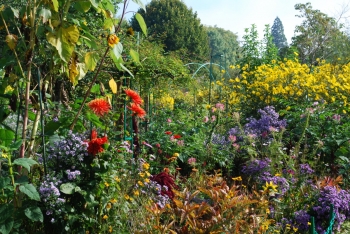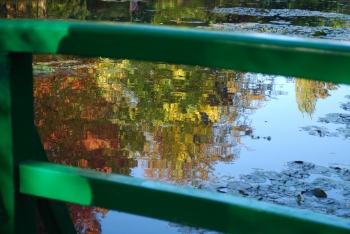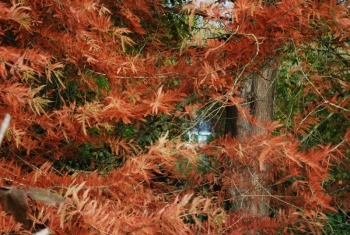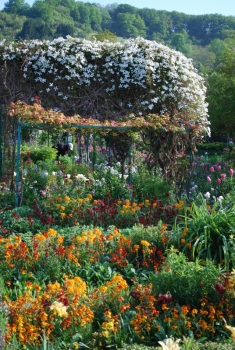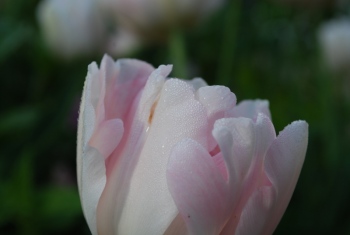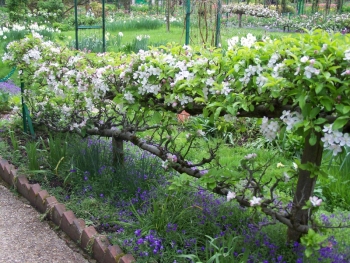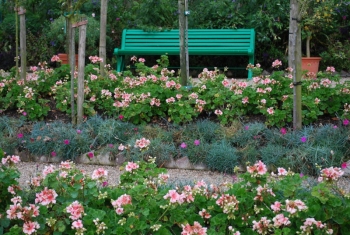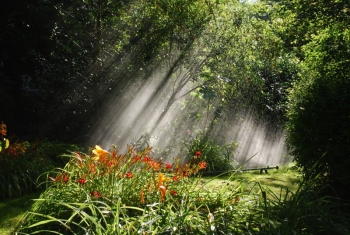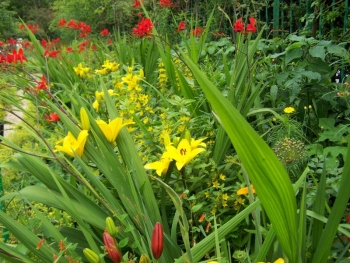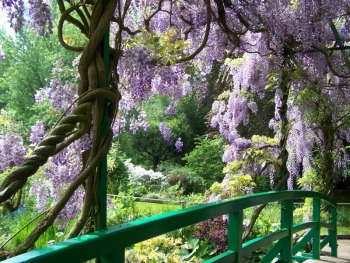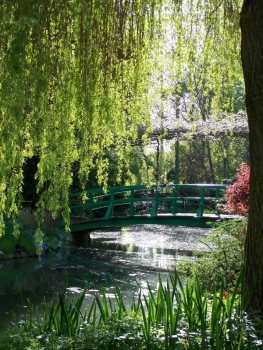November 10, 2009
The beauty of early October at Giverny, when Monet’s flower garden radiates with bright colors, is breathtaking.
It is certainly one of the best times to see the painter’s garden, more impressionist than ever.
Huge bouquets of sunflowers, asters, dahlias, cosmos mix their colors to create an overwhelming effect.
The metallic arches and tripods vanish in this sea of flowers, as well as visitors.
Posted in Monet's flower garden No Comments »
October 30, 2009
Fall is a talented artist who paints beautiful works on Monet’s water lily pond at Giverny.
Late October is the best time to admire the warm reflection of foliage on the surface so often painted by the master of Impressionism.
Liquidambars, weeping willows, poplars, taxodium, beech, chestnut trees all offer their brightest tones duplicated by the mirror of the lake.
Then the breeze comes like a magic stick to blur it all and turn the perfect images into nature’s brushstrokes.
And the little green bridge is there to frame it all.
Posted in Giverny, Water-Garden No Comments »
October 26, 2009
Monet’s gardens at Giverny will soon close: next Sunday in the evening, on November 1st. Just before their Winter sleep, they offer a gorgeous show on the side of the water garden.
The tall trees that surround the pond change their green or dark red colors for much brighter ones.
The taxodium becomes as red as a squirrel. It will last a few days and then it will loose its needles, until new ones grow next Spring, giving it a fresh green look.
Through the branches of the taxodium, like a spying eye, one can spot a window of Monet’s house in the distance.
Posted in Monet's House, Water-Garden No Comments »
May 14, 2009
How many gardeners are there at Giverny to tend Monet’s garden, is one of the questions visitors ask most often.
The five acre garden is maintained by eight gardeners.
Some visitors don’t believe me: eighty? they repeat, unsure they have heard well. No, eight only. They do a fantastic job.
In the garden, flowers are changed twice or thrice a year, according to the seasons. When spring flowers are spent they are replaced by summer flowers. This enormous task enables the garden to look very different through the seasons. Spring flowers are small, whereas summer flowers are giant, as tall as sunflowers.
In November all the flowers are pulled out again, the planting of the spring bulbs will take several weeks. The very skilled gardeners of Monet’s estate have a lot of work to do during the winter also, while the property is closed for five months.
In addition, most of the flowers are self produced in greenhouses located in the village of Giverny. This keeps several gardeners busy year round.
It is a hard job to be a gardener in heaven.
Posted in Monet's flower garden 1 Comment »
May 2, 2009
What would be Spring without tulips? They illuminate April in Monet’s garden at Giverny.
According to the head gardener, the list of the varieties displayed in the garden is very long: several hundreds of types of tulips make the Clos Normand sort of a flower show.
It is unbelievable how different the tulips can be. Their colors range from pure white to almost black red, from light pink to deep purple, from pale yellow to bright orange. They can be ridiculously tiny, or incredibly tall. Some are classically round shaped, other ones look like stars, or are as twisted as a flame. The parrot tulips seem tightly shut jaws.
But all of them have this silky quality of petals that reminds of the shine of skin, enhanced by dew in the morning sunshine.
Posted in Monet's flower garden, Flower No Comments »
April 22, 2009
Trees in blossom make Giverny especially beautiful in April, like many gardens.
Monet’s garden was originally an orchard. When the painter-gardener transformed his garden into a living painting, he kept few fruit trees: they looked too common for him, Monet preferred more exotic species. But he still had espaliered pear and apple-trees leaning against the high stone walls.
He also cultivated them around a square lawn pruned in a shape that is called cordon (rope, maybe?). It is quite common in Normandy and looks very pretty.
When the apple trees are very young, two or three years old only, they are severely pruned. The gardener keeps one branch only on each side of the trunk. In Monet’s garden there is an upper tree and a lower tree, and they cross. The purpose for this clipping is to make lovely hedges and to obtain bigger apples, as they get a lot of sunshine and water. It is not always very convincing that the trick works, but at least the apples are easy to pick up… and very tasty!
Posted in Monet's flower garden 3 Comments »
November 7, 2008
Nobody will sit on the benches in Monet’s garden anymore this year. Giverny is closed for five months.
Last Sunday evening, when the last tourist left the museum, the garden was still full of blooming geraniums, dahlias and of many annuals.
All of a sudden, everything changed dramatically. No visitors anymore in the alleys, but the very busy gardeners. One of their first task is to put all the benches in a safe place, where they will be cleaned, repainted and repaired this winter.
Another important job is to shelter the fragile flowers which are grown in pots. Within days all the flower beds will become empty and bare, ready to resist the first frost.
But for the moment the weather is mild. Cows are still outside in meadows as green as usual thanks to the almost daily rain. In Monet’s garden the leaves of the glowing liquidambars fall silently onto the pond, whilst their admirors have gone.
Posted in Monet's flower garden No Comments »
August 8, 2008
The sunshine creates rays of light through the mist produced by the watering device in Monet’s garden.
In the summertime most flowers need a lot of water to remain beautiful.
In Monet’s gardens at Giverny the sprinklers are on duty early in the morning and in the evening, to save water and to avoid that visitors get wet, of course.
Posted in Monet's flower garden, Water-Garden No Comments »
July 12, 2008
In Monet’s garden at Giverny, yellow and red flowers unite their flame-like radiant colors.
This effect is obtained by mixing yellow flowers, especially liliums and spotted-loosestrifes with delicate red crocosmias.
Croscosmias leaves have also translucent qualities enhanced by the morning sunshine.
Posted in Monet's flower garden No Comments »
May 14, 2008
The wisteria is at its peak over the Japanese Bridge in Claude Monet’s garden.
Its flowers look like long grapes. They are a soft tone of lavender and produce a delicious scent which recalls to the scent of jasmine.
It is an incredible feeling to stand on the bridge and be surrounded by the blooming wisteria all around you.
The beautiful effect doesn’t last very long, but Monet had thought of a special jocker. A second later wisteria will follow the lavender one when it is over. The second one is a white wisteria.
Posted in Water-Garden 1 Comment »
April 27, 2008
Spring has come suddenly. It was warm and sunny today, and the sunshine enhanced the bright colors of Monet’s flower garden.
In the water garden the azaleas are in full bloom. On the trees the little leaves look tender and fresh.
April light has a special quality, a sort of sparkling effect that can be noticed on Monet’s footbridge seen into backlight.
Posted in Water-Garden 1 Comment »
